| The Top 10 World's Biggest Derbies! (Photos) by timbros(m): 2:03pm On Apr 30, 2016 |
The derbies, the rivalries, the stadiums you need to experience, the games you need to see before you die: FourFourTwo presents football's biggest fixtures...
Overview
Football is a competitive game. We measure our progress against others, in leagues and cups, and the general idea is to win. But some wins are better than others.There’s no feeling quite like a victory in a derby match against your nearest and most-hated opponents. Sometimes it can help to win a league or cup, on other occasions it might seal your promotion or their relegation, but there’s no such thing as a meaningless derby.
These are the games that decide who laughs last and loudest in the office, classroom, shop-floor and forum. These are the games you love to win and hate to lose. They can make or break your season – longer, if you’re in different divisions.
A quick note on inclusion rules. We've stuck to club teams, deciding to deal with international rivalries in a separate feature. We haven’t chosen any team twice: no matter how many foes you despise (or how widely hated you are), you’re only allowed one mortal enemy. The vast majority of these derby rivals are geographically close – the same city or the one just up the road – but there are some exceptions (you can probably name one or two immediately). Oh, and for each fixture we've listed the teams in alphabetical order: no, we don't think they're a bigger team than you. Interesting article this. I felt I should share it here in Nairaland. There are 50 derbies listed but I decided to list the Top 10 here. For the full 50 World's Biggest Derbies, click this link http://www.fourfourtwo.com/features/fourfourtwos-50-biggest-derbies-world#:UTG6lT41DEh58APhoto credit: www.fourfourtwo.comEnjoy! 
|
| Re: The Top 10 World's Biggest Derbies! (Photos) by timbros(m): 2:03pm On Apr 30, 2016 |
No.10: Al Ahly vs ZamalekAl Ahly vs Zamalek is where football meets history and politics, a wholly embraced excuse for Egypt to go mad for a bit.
Formed in 1911, Zamalek represented Cairo’s wealthy expatriates: the club’s early name of Al Mukhatalat (‘Mixed’) signified the combination of Egyptians and Europeans playing together. By contrast, Al Ahly means ‘National’, and from their founding in 1909 the club came to represent the rising nationalism and longing for independence from colonial interference.
The first derby took place in 1917, but things really cranked up in the middle of the last century. On the field, the Egyptian Premier League was born in 1948; off it, King Farouk favoured Mukhatalat – but he was deposed in 1952, and Ahly quickly made the new ruler General Nasser their club president. With the clubs now clearly seen as representing royalism and nationalism, derbies became a focal point for dissent and violence. In 1966 one was halted when the army stormed the stadium and a riot a broke out; the league didn’t properly restart for five years.
Death and destruction
“The rivalry was extended to the stands in the early ‘70s, when violent clashes led to destruction and death,” recalls Egyptian football journalist Youssef Khalifa. “As a result, the league was cancelled for that year. A Molotov cocktail of fiery clashes and explosive match-ups has ensued ever since.”
Among all that, there has been a lot of successful football. Despite the weight of history, to many modern Egyptians the clash of Africa’s two most successful clubs is a fine opportunity for escapism from everyday life. Besides the estimated 50 million domestic TV audience, the game is huge all over North Africa and the Middle East.
It only adds to the interest (and intensity) that the two clubs have enjoyed a near-duopoly over Egyptian football. Of the 56 league titles, Al Ahly have won 37 and Zamalek 12, while Al Ahly have been African champs eight times to Zamalek’s five. Not without reason is it called Likaa El Kemma: ‘Meeting of the Best’.
We predict a riot
Government restrictions on private investment prevent the two teams from attracting big foreign players, but what the fixture lacks in star quality it more than makes up for in incident. Riots, brawls, military intervention, player walk-outs, abandonments: you name it, this game has had it.
The atmosphere is truly extraordinary. Cairo comes to a standstill on derby day, helped by the fact that all games are played in the neutral national stadium in front of an evenly-split 100,000 crowd. Deafening noise, blinding colour and violence of some sort are guaranteed. As the Scottish World Cup referee Hugh Dallas told FFT in 2003, “You just don’t realise quite how big it is until you see it for yourself.
“I’ve done 14 or 15 Old Firm matches and even they don’t come close to this,” continued Dallas. “I genuinely believe that this is as big as it gets.” The Scotsman one of several overseas referees brought in to take charge of the game since 1996 to ensure impartiality.
Match abandoned
Not that it helped much. In 1996, Zamalek walked off the pitch in protest after the French referee sent off one of their players five minutes into the derby, causing the match to be abandoned. They were deducted nine points – the most in the league’s history. The most thrilling football arguably came in the 2007 Egyptian Cup Final when, inspired by club and legend Mohamed Aboutrika, Al Ahly thrice came from behind to win 4-3 in extra-time.
The fiercest rivalries
Why derbies really matter to us – and always will
And that’s without mentioning Hossam Hassan, Cairo’s combination of Sol Campbell and Luis Figo. Egypt’s record cap-holder and scorer became a playing legend in two spells for Al Ahly before everything went a bit weird at the turn of the millennium. Al Ahly only offered the 33-year-old legend a one-year extension, while leaning on his twin brother Ibrahim (another cap centurion) to retire. The twins decided instead to join the eternal enemy, sparking several run-ins with the Al-Ahly fans, especially as Hossam led Zamalek to three league titles in four years.
Any idea that this might be a mere parting gesture, akin to Johan Cruyff’s pre-retirement season with Feyenoord, would be firmly rebuffed when Hossam became Zamalek manager in 2009. Freed of the need to run around, he became even more demonstrative as a boss. Among his greatest hits were sparking a brawl involving staff, players and fans and walking over to a stand full of Al-Ahly fans, laying a Zamalek shirt on the ground and kneeling to pray on it. As you do. 



|
| Re: The Top 10 World's Biggest Derbies! (Photos) by timbros(m): 2:03pm On Apr 30, 2016 |
No.9: Borussia Dortmund vs SchalkeIt took nearly 40 years for the Ruhr derby to really get going.
Borussia Dortmund may have been formed in 1909, but they weren’t even the dominant force in their own city until 1936. Schalke, from neighbouring Gelsenkirchen, held the championship of Westphalia for 21 consecutive seasons - but things changed on one grey afternoon in May 1947.
Then Dortmund finally broke the Schalke stranglehold with a 3-2 win in the driving rain – twice fighting back from a goal down to claim victory five minutes from time.
Suddenly the Revierderby – the local name for the match, meaning ‘the derby of the area’ – had been spiced right up.
Bundesliga battle
Things grew even more intense after the launch of the Bundesliga in 1963. The mono-cultural Ruhr region – fired on coal and built on steel – slid into economic meltdown from the late 1970s and the area’s two most successful clubs were suddenly struggling to compete with teams elsewhere in the country.
Football frustration and social despair soon blended with the sporting rivalry to yield frightening results. In 1979, Schalke hooligans formed what would quickly become one of the most notoriously violent firms in Germany - the ‘Gelsenszene’. To counter the threat, Dortmund thugs founded the fascist ‘Borussenfront’ in 1982.
For the next decade the two groups tore into each other. In 1984-85, 64,000 fans flocked to Schalke's ground for a game with Bayern Munich – only 41,000 dared to turn up for the derby.
"Ruhr, Ruhr..."
Yet curiously, regional rivalry lives alongside regional pride. On May 21, 1997, Schalke pulled off a major upset to win the UEFA Cup against Roy Hodgson’s highly fancied Inter Milan side. On May 28, Dortmund followed suit by stunning star-studded Juventus to win the Champions League.
Those seven amazing days capped both clubs' unexpected rise during the 1990s, from rags to riches, from relegation fodder to European heroes. Fans weren’t entirely agreed on how to react.
One half of the Dortmund supporters at the Champions League final reveled in a spot of one-upmanship, chanting that their own achievement was ‘a class above’ above Schalke’s victory. The other half of the supporters turned on them and began to sing ‘Ruhr, Ruhr’, in celebration of the fact that the region was suddenly dominating European football.
A year earlier, when Schalke defeated Bayern to qualify for the European Cup, their fans had also sung ‘Ruhr, Ruhr’ as news filtered through that Dortmund had beaten Bayern to the league title. It’s the sort of regional unity that is unlikely ever to happen in Manchester or North London, for example.
Moller's time
Dortmund and Schalke fans admit to being alike in many ways, yet the antagonism remains prevalent. Fans of these similarly-sized clubs clearly hate each other.
Euro 96 star Andreas Moller became an instant villain on both sides when he crossed the divide to join Schalke in 2000 - even fans of Moller’s new club weren’t happy about it.
As one Schalke supporter called Stuart told FFT: “I got a phone call from another fan saying, ‘The world has ended, we have signed Andreas Moller!’ I had to drive over to console him. He said he'd never go to a Schalke game again. The next season was Schalke's greatest year in living memory. But he didn't go to a single home game.”
Meanwhile, goalkeeper Jens Lehmann had moved in the other direction shortly beforehand, albeit via Milan. He had begun his career at Schalke, dramatically scoring a last-minute equaliser against Dortmund in 1997.
Mother of derbies
Dortmund then went 13 games without a league derby win between November 1998 and May 2005, but they got their revenge on their rivals on the penultimate day of the 2006-07 season, beating Schalke to deny the Miners the title in what was dubbed as ‘The Mother of all Derbies’.
Why derbies really matter to us – and always will
While Schalke dominated the pre-war years, derbies have been pretty even in the Bundesliga years - despite Dortmund winning the title five times, while Schalke have had to make do with a quintet of runners-up spots. In 2008, Dortmund fans held special celebrations to mark Schalke’s 50 years without a league title.
But the truth is that the Ruhr derby’s antipathy probably stems from the fact that both clubs are so alike.
“Both clubs were started, run, then supported by coal and steel workers,” says Uli Hesse, author of ‘Tor! The Story of German football’. “So why do the two hate each other so passionately? Perhaps precisely because they are so similar. In school, we learned that like charges repel each other.” 

|
| Re: The Top 10 World's Biggest Derbies! (Photos) by timbros(m): 2:04pm On Apr 30, 2016 |
No.8: Gremio vs InternacionalNothing else matters in the Southern state of Rio Grande do Sul, where being neutral is impossible...
Down in the southernmost state of Brazil, the Gaucho-country Rio Grande do Sul, you’ve got a choice: you’re either Gremio or Internacional.
The two sides share the state capital Porto Alegre and command roughly equal slices of its metropolitan area’s 4.5m inhabitants, having carved up the Campeonato Gaucho state championship in similar style: of its 95 titles, they’ve won 80 (Inter shading Gremio 44 to 36).
Gremio are the older club, founded in 1903 by one of those rich enthusiasts who helped popularise the game we all love. (Thanks, rich enthusiasts!) But it was a private members’ club for those of German ancestry, which six years later irked the Italian-descended brothers Henrique, Jose and Luis Poppe into forming Internacional, the name a pointed snook cocked at the city rivals.
The two sides share the state capital Porto Alegre and command roughly equal slices of its metropolitan area’s 4.5m inhabitants
Such righteous indignation and all-encompassing internationalism didn’t help Inter in the first “Grenal” derby, in July 1909: the older club ambled to a 10-0 triumph so comprehensive that some reports have the Gremio goalkeeper walking off the pitch for a chat with supporters.
Things quickly got closer. For much of the century-long rivalry the sides have been evenly-matched, adding a genuinely competitive edge, and not just at the regional level: they’ve won two Copa Libertadores each, Inter have three Brazilian titles to Gremio’s two, and the younger club are also slightly up on the head-to-head.
The steamroller factory?!
By their 50th anniversaries, the teams were attracting the sort of loyal followings that make a club have to seek pastures new
Inter have gathered some fine nicknames along the way. Already known by the excitingly cowboyish Colorados because they play in red, a particularly impressive 1940s saw them christened Rolo Compressor – The Steamroller. Other sobriquets included Celeiro de Ases (Factory of Aces) and Campeão de Tudo (Champion of it All), which makes up what it lacks in humility with inclusion. And inclusion was the key to that great 1940s team, which included all ethnicities at a time when this was far from a uniform policy in Brazilian football.
By their 50th anniversaries, the teams were attracting the sort of loyal followings that make a club have to seek pastures new. In 1954 Gremio moved from the 15,000-capacity Baixada to the 45,000 Monumental (where they stayed until moving to the spanking-new 55,000-seat Arena de Gremio in 2012).
Inter also outgrew their 20,000-capacity Estadio dos Eucaliptos but the replacement Beira-Rio took more than a decade to get built, not helped by a dip in on-pitch fortunes and the usual Brazilian flair for local government efficiency. It finally opened in 1969, and was substantially remodelled to a 50,000-seater for Brazil 2014 – having been preferred to Gremio’s stadium, to the delight of Inter fans.
And those stadiums aren’t the soulless identikit affairs you see in some cities. You’ll get enormous banner displays, flares and smoke bombs setting off the colourful clash of Inter’s red against Gremio’s light blue, black and white tricolor, while your ears are soothed or assaulted by the musical locals and their endless singing.
Indeed, while Inter’s paying membership is in six figures (the highest in South America), Gremio fans have a well-earned reputation for being among the most fanatical in Brazil, which is quite some accolade when you think about it. The new stadium has a designated standing area behind the goal, where their hardcore support developed a signature move called ‘the avalanche’: celebrating a goal by legging it down the terrace toward the pitch to celebrate with the players. Unfortunately, The Man deemed the move too dangerous and metal crush barriers were soon installed. Boooo!
Men of the match
In any derby, heroes will arise. Gremio’s include the buck-toothed 18-year-old, name of Ronaldinho, whose stunning display in the 1999 state final included the match-winning goal (after a nutmeg and a one-two) and even a flick over the head of his alleged man-marker: the World Cup-lifting captain Dunga.
Then there’s Eurico Lara. Despite a heart condition, the legendary Gremio keeper was determined to play in a 1935 Grenal; upon conceding a penalty, he was reminded by the taker – who happened to be his brother – that his doctor had told him to take it easy. Ignoring the fraternal advice, he saved the spot-kick but had to be subbed and died within two months. He’s celebrated in Gremio’s anthem.
As for Inter, they love to recall 1989’s ‘Grenal of the Century’: after a goalless first leg, the second part of the Brazilian Championship semi-final – and with a Copa Libertadores place also at stake, it was winner-takes-all in front of almost 80,000 fans. Trailing 1-0 at half-time and down to 10 men in 40-degree heat, Inter stormed back to win 2-1 with two goals from the injured Nilson.
Such things create legends. As FFT’s Brazilian correspondent Mauricio Savarese notes: “In the week before the derby, nothing else matters in the Southern state of Rio Grande do Sul, where being neutral is impossible. When Inter dominated Brazilian football in the ‘70s, Gremio struggled. In the ‘80s, it was the other way round. It’s been a see-saw ever since, but come matchday, these two giants of Brazilian football are, and will always be equal.” 
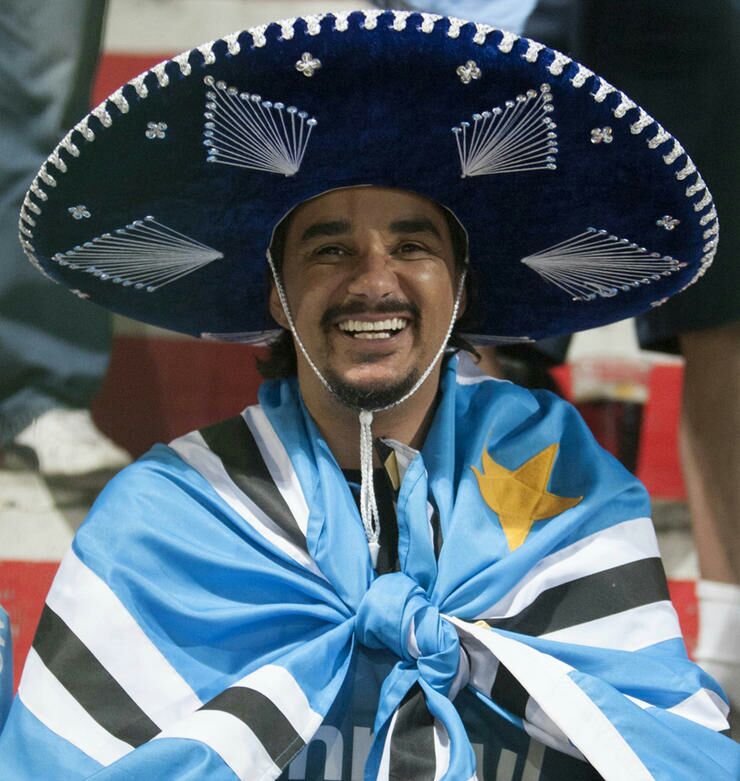

|
| Re: The Top 10 World's Biggest Derbies! (Photos) by timbros(m): 2:04pm On Apr 30, 2016 |
No.7: Liverpool vs Manchester UnitedFirst things first: we’re perfectly aware, thanks, that each of these clubs has its own local derby with nearby shades of blue. And we know full well that those parochial affairs are intense and important, to local pride and national tables.
But if you ask most fans of these two teams which opponent they most want to beat, it’s that lot in red, at the other end of the East Lancs Road; that bunch with the daft accents, the smug superiority complex, the lack of class, the iconically imperious Scottish manager and the trophy list which isn’t quite as impressive. Their alter ego.
This clash of the north-west giants is in some ways the story of English football, or at least its last half-century. They have won 38 top-flight titles, while the rest of the country’s combined efforts come to 78; 24 of their triumphs came between 1973 and 2013, with each having a two-decade dominant period which no other English side has come even close to matching.
And their sibling rivalry is centuries old. Industrial Revolution powerhouses built on working-class populations with a strong Irish influx, they were linked by the world’s first passenger railway in 1830. But they had their squabbles, too: when inland Manchester thought the port of Liverpool was charging over the odds for trade, they dug a 40-mile Ship Canal and became the country’s third-biggest port.
Rise and fall, fall and rise
Before the Second World War, the clubs weren’t even the biggest in their respective cities, but by the 1960s they were coming nicely to the boil. Led by two Lanarkshire friends, Bill Shankly and Matt Busby, the sides started to win competitions and fans, and there was mutual respect: United players would stand on the Kop to watch games, while in 1966 Liverpool fans voted Busby captain of their all-time XI.
United won England’s first European Cup in 1968, but Liverpool shifted into another gear just as the Red Devils drifted into a quarter-century title drought. That coincided with an increased hostility that still lingers, and in some ways worsened when the seesaw tipped in United’s favour. The derby day is still the most edgy on each club’s calendar, even if the atmosphere isn’t quite what it was in the terrace heyday of the 70s and 80s.
That atmosphere carried menace, though. As the avatars of big working-class cities suffering deindustrialisation and depression, each side attracted a hooligan element. The rivalry became malignant, revelling in violence and death, with small but vocal minorities enjoying sick chants about deaths affecting the others – Munich and Shankly, then Heysel and eventually Hillsborough.
As former United midfielder (and Kop-visitor) Pat Crerand put it: “When I go to Anfield now, I speak to long-standing Liverpool fans who can’t put up with what the rivalry has become: the hooliganism and the nastiness. Liverpool and Manchester are working-class cities that have produced two of the greatest football clubs in the world. People should be proud of that, but they’re not.”
Global brands
Compared to the ugliness of the 1980s, what some might call the gentrification of football in the Premier League era has made for a different sport. Quick to expand their footprint, on both the geography of a rapidly expanding Old Trafford and the economy of a TV-fed global market, United have benefited hugely, bankrolling more players for more success
Why derbies really matter to us – and always will
Liverpool, until recently more restricted by the neighbours and certainly less go-ahead commercially, have fallen further behind but still retain an enormous pull across the planet. Those lunchtime derby kick-offs aren’t merely to curb alcohol-fuelled aggro: they help to reach United’s 75m global fanbase and Liverpool’s 200+ fan clubs in 50 different countries.
It’s little wonder, really. Over the past half-century, games between these two world-famous sides have perhaps featured more iconic talent than any fixture bar El Clasico.
And those games have frequently been must-sees, either trophy deciders or simply barnstorming games. United’s 1977 FA Cup Final victory denied Liverpool what would have been a Treble, but Ronnie Whelan’s curled cracker won back some revenge as well as the 1983 League Cup. In 1994 Liverpool pegged champions United back from 3-0 down, but five years later United came back from a goal down in the last two minutes to win an FA Cup thriller.
Last word to Andy Mitten, the United fanzine editor whom FourFourTwo forced to sit on the Kop in 2007: “Separated by 33.3 miles of flat hinterland, England’s two biggest clubs provoke mutual loathing and haven’t conducted transfer business for 50 years, yet have more in common than not. Bound by suffering at Munich and Hillsborough, their greatest managers were Scottish, and both clubs enjoy huge matchgoing support in the largely working-class cities they call home. These bitter rivals are more alike than they’d care to admit.” 


|
| Re: The Top 10 World's Biggest Derbies! (Photos) by timbros(m): 2:05pm On Apr 30, 2016 |
No.6: Fenerbahce vs GalatasarayWhen it comes to planting flags, like all things in life, there’s a time and a place. After landing on the Moon, yes. In the middle of Fenerbahce’s pitch if you’re the Galatasaray manager and you’ve just beaten them in a cup final, no. Definitely no.
“When I planted it and turned around, I quickly realised there were a number of supporters trying to get on to the pitch,” Souness recalled.
Thankfully for Souey, he at least emerged unscathed from his ill-timed homage to Neil Armstrong and Buzz Aldrin. Well OK, it wasn’t actually in honour of Buzz, it was a response to the vice president of Fenerbahce, who had branded Souness ‘a cripple’ following the Scot’s open-heart surgery.
“The foulest... the lowest”
There’s never been much love lost between two Istanbul clubs from different sides of the Bosphorus – in fact, from different continents. Galatasaray are from Europe, Fenerbahce just a few miles east in Asia.
“Fenerbahce are the worst team in the world,” a rather agitated Galatasaray fan once told FFT. “The foulest, the lowest, the most dishonourable. They’re nothing and their fans are even less.” Rest assured, the feeling is mutual.
The Intercontinental Derby doesn’t fit neatly into any of the classic paradigms for local rivalries. There is no ethnic split between the clubs and no religious divide, although historically, social class played a part in forging the identity of each.
In the 1970s, a leading Turkish academic (and Fenerbahce fan) described Galatasaray as the club of the Europeanised aristocracy, labelling Fenerbahce as the club of the bourgeoisie.
Galatasaray were founded by old boys from Istanbul’s equivalent of Eton, the Galatasaray High School, a 400-year-old institution built to provide a French-language education for the elites of the Ottoman Empire. It was there, in 1907, that Ali Sami Yen convinced a group of his friends that they should start a football team, presenting them with a ball repaired with leather cut from his own shoes.
Fenerbahce, meanwhile, were a club built on the new money of an economically thriving Anatolia. They were regarded as a microcosm for the rapidly modernising Asian Turkey: ambitious, hard-working, financially astute.
Ataturk the icon
The club’s identity with the Asian hinterland goes all the way back to Fenerbahce’s most famous fan: Mustafa Kemal Ataturk, the hard-drinking general and statesman who is regarded as the founder of the modern Turkey in 1923, and who is supposed to have blessed Fenerbahce with a wish for their “eternal success”.
Laying claim to the support of such a talismanic national icon is controversial, but most now accept that Ataturk did have a special affection for Fenerbahce, and the story of the great man’s visit to the ground by the shores of the Marmara Sea in 1918 is enshrined in the club’s official history.
The club and its fans are fiercely proud of their support for the war Ataturk fought against invading Greeks to establish the Republic of Turkey amid the wreckage of the Ottoman Empire. Club folklore tells of midnight intrigue when Fenerbahce took advantage of its waterfront location to help smuggle arms and support from then-occupied Istanbul to Ataturk’s army in central Turkey.
But history has only a limited effect on today’s allegiances. “Other major derbies may have ethnic or religious differences or class at their roots, but in Turkey, things are different,” one fan told FFT. “Here, choice of club is like a kind of democratic citizenship. Anyone can become a supporter of any club. Each club has to compete for every new-born child.”
English influence
Galatasaray won the first derby in 1909, with one of the goals scored by an English expat by the name of Horace Armitage. He was the first of many to play for both clubs. Changes of allegiance being relatively commonplace, they don’t tend to generate too much heat – with one or two notable exceptions, among them Haim Revivo.
A Fener fans’ favourite, the Israel midfielder walked out on them suddenly in January 2003, claiming ill-treatment. Not short of offers from around Europe, he appeared to cock a snook at his old employers by signing a two-year deal across the Straits. Revivo probably thought better of his decision when, during a stint laid up in hospital, he looked out of his window to see the building besieged by angry Fenerbahce fans brandishing banners bearing the legend ‘Traitor’. A few months later he was heading back to Israel.
Tension had first started to build up in 1934, when a mid-match brawl forced the abandonment of a friendly match between Cimbom and the Yellow Canaries. These days, the two clubs have supporters scattered across the planet.
“Forget Glasgow, forget Barcelona,” said one fan, who had travelled 870 miles from near the Syrian border to watch this fixture. “This is the biggest derby in the world.” 


|
| Re: The Top 10 World's Biggest Derbies! (Photos) by timbros(m): 2:07pm On Apr 30, 2016 |
No.5: Lazio vs RomaIt’s unusual for a capital-city derby to feel so parochial, but the Rome rivalry rarely affects matters at the top of the table: Roma and Lazio have collected only five scudetti between them.
While the colder northern cities hoover up the trophies, the games that matter to Roman fans are for local pride, for bragging rights in the bars and piazzas of this warm Mediterranean city where neighbours coexist in public spaces, ceaselessly teasing each other over the last derby and the next one.
As Paolo Di Canio – who knows a derby when he sees one, having been involved in Rome, Milan, Sheffield, London and Glasgow ones – puts it: “Apart from the Old Firm, nothing compares with the derby of the Big Dome (St. Peter’s). The build-up is huge, nothing else matters. Roma and Lazio fans care more about winning the derby than where they finish in the league.”
Enjoy the spectacle
The Roma vs Lazio derby is the best show in Italy. The fans like to outdo each other with displays.
Witty and ironic, the Roman temperament is well-suited to football fandom. Sharpened on the street, the banner-based banter between Lazio’s Curva Nord and Roma’s Curva Sud can be as eye-catching as the game itself.
As an example, for a 2000 derby the Roma fans had produced a giant tifo telling their side “Look up: Only the sky is bigger than you.” To which the Lazio fans – who had taken in an enormous blank canvas and paint, like opportunist art-school pranksters – responded: “You’re right: it’s blue and white.”
“The Roma vs Lazio derby is the best show in Italy,” says Rodrigo Cacho, a Roma fan lecturing at Cambridge University. “The fans like to outdo each other with displays. As well as being friendly, outspoken and convinced that they know everything, Romans are fixed with the idea that they are at the centre of the world – neither northern nor southern – but special and living in the most beautiful city.”
Add in the clever choreography of flags, flares and fireworks and you’ve got quite the sensory assault.
...but then again
In 2004 fighting broke out during the match after a rumour spread that a boy had been killed by a police car.
However, “assault” might be the right word. Calcio’s first violent death came at a Rome derby: in 1979, a flare fired by Roma fans killed Lazio supporter Vincenzo Paparelli. As many English fans have found, bridge-based ambushes and buttock-stabbings seem to be Roman favourites; derbies do nothing to quell those urges.
Some ascribe the argument to politics, but as is often the case that’s somewhere between a generalisation, an extrapolation from a few carefully selected facts and a flag of convenience.
It may once have been true that to a certain extent Roma were the left-wing inner-city working-class team to Lazio’s middle-class suburban right-wingers, but Roma were formed at the behest of a Fascist Party official, while Lazio later thwarted Mussolini’s desire to form a Roman superclub from the two.
And for all the easy macho posturing of what Di Canio insists was a “Roman salute”, no football fan throwing a punch or a flare is doing so over their core beliefs on the equitable distribution of wealth. Besides, Roma’s more meat-headed followers are as likely to be right-wing racists as Lazio’s are.
General strike
Sometimes, the violence isn’t necessarily tribal but anti-authoritarian. In 2004 fighting broke out during the match after a rumour spread that a boy had been killed by a police car; Roma skipper Francesco Totti, who is close to the ultras and is rarely one to keep his counsel, persuaded the referee to telephone the league president Adriano Galliani and request a postponement. That gave both sets of fans free rein to riot for hours, with 13 arrests and more than 150 injuries.
And on a lighter note, the fans have been known to rally together to defeat a greater enemy. Before the 2013 Coppa Italia Final – one of few recent derby clashes to affect the destination of trophies – the two tribes joined together in noisily booing a performance of South Korean pop wazzock Psy’s globally infecting ear-irritant Gangnam Style.
“Other derbies are covered with more glory, but nowhere is there such a definitive challenge like Roma-Lazio,” says Tancredi Palmeri, beIN Sports’ Italian correspondent. “For many in Rome, the results in these games and finishing above their rivals in the league are all that matters.
“Because this is a city where there are 15 successful radio shows that talk every day, every hour about Roma and Lazio. Not about football: about Roma and Lazio. Total passion, from the ground to the sky.” 



|
| Re: The Top 10 World's Biggest Derbies! (Photos) by timbros(m): 2:07pm On Apr 30, 2016 |
No.4: Nacional vs PenarolIf you were called upon to construct the ideal derby, your ingredients might be as follows: longevity, mutual national pre-eminence, a historical schism, legendary venues, breathtaking tifos, comic escapades and recent beefs. No need to get inventive: just get to Montevideo.
Nacional and Peñarol are the oldest club rivals outside the UK, having played their first derby back in 1900, when folks were still laughing at the Wright Brothers’ belief in powered flight.
They bicker about who’s the oldest: Peñarol claim they popped out in 1891 as the Central Uruguay Railway Cricket Club, later changing their name to the district they played in (not to mention the fact that they played football, weren’t cricketers anymore and weren’t particularly central, what with being on the south coast). Nacional (1899) claim that makes them the older club.
Nacional’s name hints loudly at a more important shibboleth. Like many a 19th-century South American club, Peñarol (or CURCC, if you insist) were founded by and largely for European immigrants, in this case English railway workers; by contrast, Nacional were the first South American club founded without any Old World involvement/interference, hence the moniker.
“Right, let’s get good”
Of the 112 seasons, they’ve won 92, with Peñarol a squeak ahead, 47 to 45
Not the type to hang about, the Uruguayans started their national league in 1900, and these two quickly set about dominating. They won two each of the first four leagues, then had a breather for a decade, then smashed it. Of the 112 seasons, they’ve won 92, with Peñarol a squeak ahead, 47 to 45. Between 1932 and 1975, nobody else won the league. At all.
They’ve even done a decent job of keeping it lively within that: unlike Celtic and Rangers each winning nine in a row, neither of these two won more than five successive league titles, so that’s nice.
Sallying forth into continental competition, Peñarol have won the Copa Libertadores five times (bettered only by Boca and Independiente) while Nacional have won it thrice – typically, the last time (1988) immediately following Peñarol, just to keep them quiet. No wonder it’s estimated that some 80% of all Uruguayan football fans support one team or the other.
Anything you can do...
The comparisons keep going, each trying to outdo the other. Nacional play at the Parque Central, built in 1900, which makes it the oldest stadium in South America; Penarol play many of their games at the legendary Estadio Centenario, which just happened to be the venue for the first ever World Cup final in 1930. Obviously all the derbies are staged at this magnificent crumbling cauldron, in front of 50-50 sell-out crowds, who welcome the teams onto the pitch with a shower of ticker-tape. South American insanity at its best.
Peñarol win the nickname-off: due to their black-and-yellow livery they’re somehow known as both the Coalmen and the Sunflowers, while Nacional’s nicknames are largely colour-based except “Bolsos”, a diminutive of the Spanish for “pocket”, which their early shirts featured.
Peñarol also broke the world record in 2011 with a 309-metre flag, the biggest ever at a football game. Two years later inthe Copa Libertadores, it was beaten by a frankly ridiculous 600-metre effort. Can you guess who from?
Echoing down the ages
A match this old, this big and this frequent – they’ve faced off over 500 times – has to have some quirky stories. Take ‘The Derby of the Bag’ in a 1933 Uruguayan Cup Final, when the Nacional physio innocently left his medical goody-sack just behind the post: a Peñarol cross hit it and bounced back into play, whereupon the rebound was tucked in and the ref, believing the cross had hit the post, allowed the goal. Nacional were livid – two men were sent off in the protest – but their eight men hung on for a draw and the game was eventually replayed.
Somewhat less glorious for Nacional was 1949’s El Clasico de la Fuga (‘Derby of the Escape’). Two goals and two men down by half-time, Nacional decided not to bother with the second half, preferring to clamber out of the dressing-room window and leg it instead. Their claims that it was a protest at the referee did little to stifle Peñarol’s chuckles.
You’ll notice both those games involved multiple expulsions, and that’s not changed down the years. A match in 1990 was abandoned after a red card sparked a brawl that resulted in 20 players being sent off. Another brawl in 2000 ended up with nine players spending a month in jail.
In recent years the clubs haven’t been as successful on the continental stage – which has only intensified the domestic rivalry, and occasionally the propensity for off-field violence. Not that the players can be accused of setting a shining example: in 2014, four were sent off, a post-match brawl saw nine spend the night in prison, and 17 were banned by the FA. And that was a friendly.
So: history, rivalry, quality, enmity and comedy. The only thing it hasn’t got is a decent name: they call it el clásico del fútbol uruguayo, or Uruguayan Clásico. Oh well, you can’t have everything. 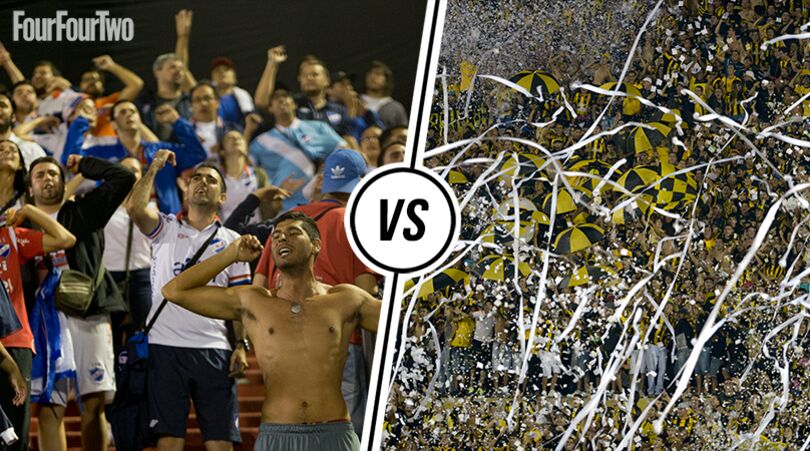

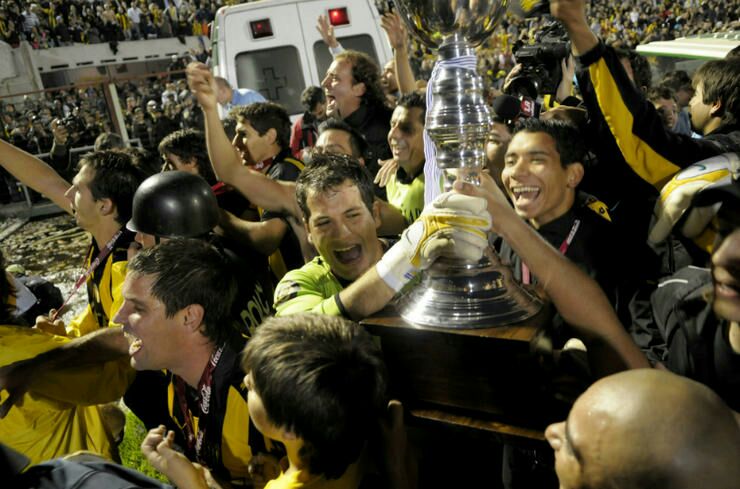

|
| Re: The Top 10 World's Biggest Derbies! (Photos) by timbros(m): 2:08pm On Apr 30, 2016 |
No.3: Celtic vs RangersIt started out as an act of kindness, then took a religious turn before attracting some of the most reputable international stars. It's Britian's biggest derby...
“I’ve been fortunate to see derby games all over the world and there is nothing that comes close,” the late Rangers great Sandy Jardine once told FFT. “When you go out of the tunnel you just get hit by this level of noise.”
“Afterwards in the dressing room your ears are still ringing,” said former Celtic defender Tom Boyd. “Even when you go back on the coach they’re still buzzing. The difficult thing with that kind of noise is trying to communicate, to organise a defence. In the cauldron it can become almost impossible – it usually involves just shouting as loud as you can. Your throat is raw after one of those games.”
The city’s chief constable Percy Sillitoe was threatening to ban the Old Firm fixture altogether in an attempt to reduce the crime rate.
Kind kick-start
It is a rivalry that has undoubtedly been stoked by sectarianism, but the Old Firm actually got off on a fairly friendly footing. Rangers had recently moved to their new permanent home on the south side of Glasgow when Celtic were founded in 1888, with the intention of raising money from matches to distribute to the poor and disadvantaged of the east end.
The two clubs met for the first time later that year, with Celtic winning 5-2. The game attracted an almost unprecedented crowd of 2,000 spectators. Eleven years later, Rangers agreed to provide the opposition as Sandy McMahon became one of the first Celtic players to receive a benefit match.
Any rivalry was confined to the pitch until the 1920s and 1930s when social, religious and political tension – as well as the rise of Glasgow’s street gangs – began to impact on football. Soon the city’s chief constable Percy Sillitoe was threatening to ban the Old Firm fixture altogether in an attempt to reduce the crime rate.
Catholics and protestants
I was in the Rangers team that lost on the last day of the season in 1979. We only needed a draw to win the league and they won the title that day.
- Gordon Smith
The city’s Catholic population, largely Irish and disadvantaged, had started to become victims of discrimination. Meanwhile, new laws allowing Catholic schools to be funded and run by local authorities created ill-feeling among the Protestant establishment. As Celtic grew ever closer to their Catholic origins, Rangers became more entrenched in Presbyterianism.
Tensions remain between Celtic and Rangers fans to this day. Although the introduction of legislation banning bottles, cans and alcohol in Scottish grounds helped to quell violence, the stigma of sectarianism is not so easily washed away.
On one side, thousands have been known to sing The Sash and other Loyalist anthems. On the other, many have sung The Boys Of The Old Brigade and eulogies to Irish Republicans. Even the most innocuous of songs can be turned into a torrent of abuse by an Old Firm crowd. Rangers once ditched their entrance anthem Simply The Best because their fans had corrupted the lyrics with references to the Pope and the IRA.
But a long-held Ibrox policy, never publicly stated but an open secret in Scottish football, is gone these days. For many years, Rangers would not sign a Catholic. Celtic had no such qualms – indeed Jock Stein, the club’s most successful manager, was a Protestant.
Things changed at Ibrox during Graeme Souness’s tenure as boss, when he signed players solely on talent rather than religious affiliations. The highest-profile Catholic arrival was former Celtic striker Mo Johnston.
It wasn’t well received by many on both sides – Celtic fans called him Judas, while some Rangers fans burned scarves and threatened to hand in season tickets. Even the club’s own kit man protested by refusing to deliver Johnston’s kit to his hotel room during a pre-season tour, despite doing so for every other player. Johnston, though, would soon get Rangers fans on his side with a winner against Celtic in an Old Firm clash.
Two teams and a title
That the two clubs have dominated the league – save for Rangers’ recent foray into the lower leagues – has also helped to intensify the rivalry. League matches have often been both derbies and potential title deciders.
“I was in the Rangers team that lost on the last day of the season in 1979,” Gordon Smith told FFT. “We only needed a draw to win the league and they won the title that day. To lose it at Celtic Park, to sit in the dressing room and hear their celebrations, was the worst feeling.”
Later Celtic would go seven years without victory at Ibrox. During that period, manager Tommy Burns suggested his gravestone would be engraved with the words ‘Andy Goram broke my heart’, in reference to the Rangers goalkeeper’s constant heroics in Old Firm matches.
The fact that defeat to Rangers in the Scottish Cup semi-finals a fortnight ago was followed so quickly by news of the imminent exit of Celtic boss Ronny Deila tells you that the Old Firm derby remains as important as ever – maybe even so after time apart, in separate divisions.
The rivalry will resume on a regular basis next season. Ear plugs at the ready. 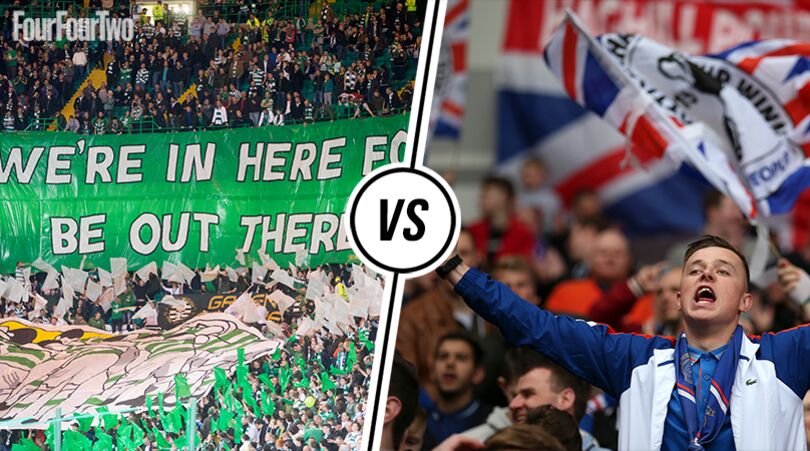
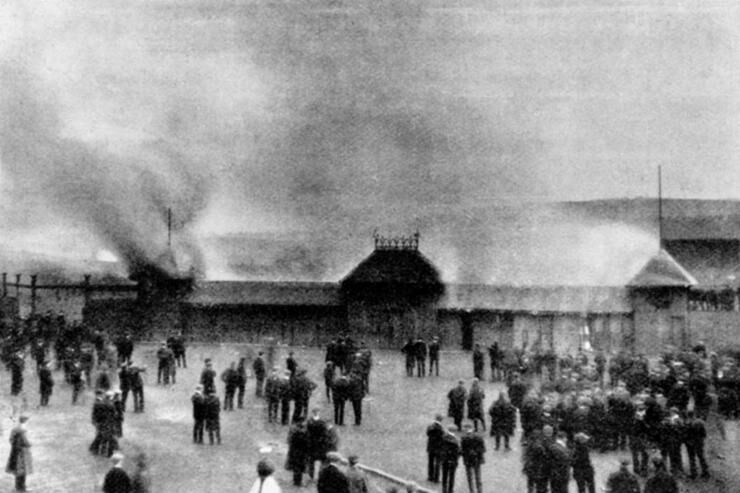
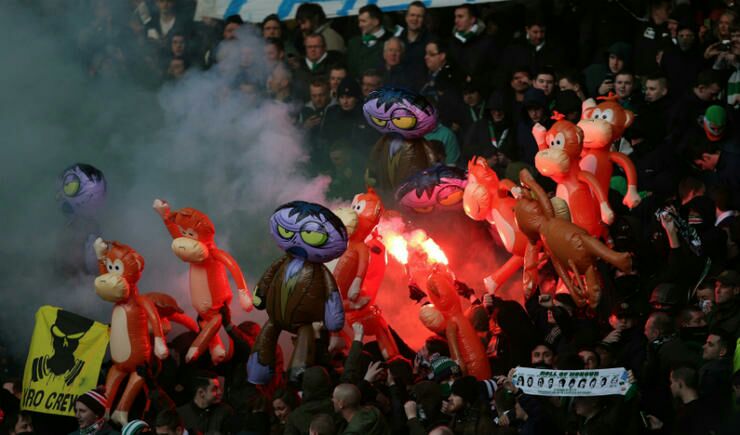
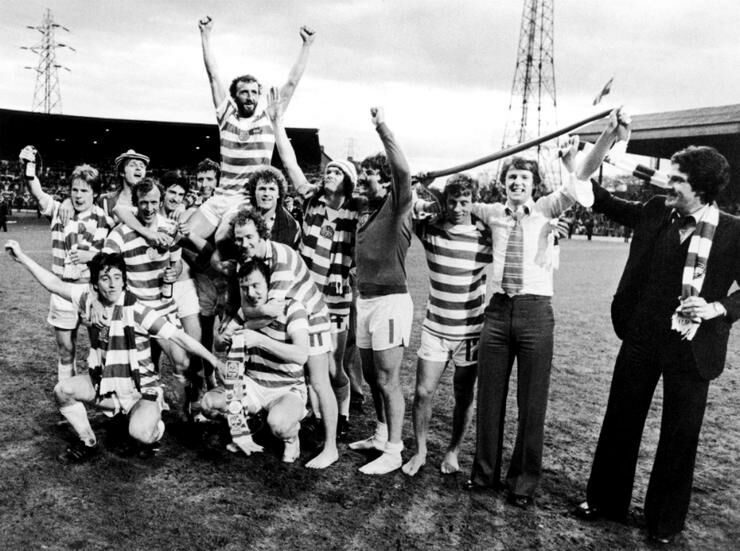
|
| Re: The Top 10 World's Biggest Derbies! (Photos) by timbros(m): 2:08pm On Apr 30, 2016 |
No.2: Barcelona vs Real MadridEl Clasico is just kept off top spot as the biggest derby in world football...
There are games between clubs, and there are games between countries. And somewhere in the middle is FC Barcelona vs Real Madrid.
Bobby Robson’s description sums up the beef at the heart of this rivalry: “Catalunya is a country and FC Barcelona is their army.” In fact, Catalunya is an autonomous community within Spain, and Barça’s players don’t usually take to the field in tanks, but the world-famous football team is the most visible manifestation of Catalan pride.
It always was, which presented problems when Franco would really rather everyone knuckled down as straightfroward Spaniards. Like the Basques, Catalans felt squeezed by a centralised government who sought to ban their language and culture. As it’s rarely wise to protest against a government led by a General, Real Madrid stood as a cipher for the regime, football a focus for the discontent.
They’re also by far Spain’s biggest and best clubs, winning 55 (Madrid 32, Barcelona 23) of the 84 national league titles. That duopoly is constantly reinforced by the imbalanced structure of TV deals, which matters when every game between the two clubs is watched by an estimated half-billion global audience. It’s arguably the planet’s most eagerly-awaited and widely-devoured fixture.
It helps when the teams involved have such a fantastic array of players. At the moment it’s BBC vs MSN – Madrid’s Bale, Benzema & Cristiano (Ronaldo) against Barça’s Messi, Suarez & Neymar – but this fixture has had probably the finest dramatis personae in football’s storied history, from Maradona, Cruyff, Di Stefano and Zidane on down.
Enemies from the off
But back to the history – you’re never, ever far from history with this fixture. Madrid Football Club formed in 1902 and gained royal (hence Real) patronage in 1920, proudly wearing a crown atop its badge ever since.
Founded in 1899 by a mix of Swiss, English and Catalan enthusiasts, FC Barcelona has always mixed an internationalism with a fiercely proud Catalanisme. That didn’t sit well with Francisco Franco, who led the coup d’etat that started the Spanish Civil War and set about neutering separatist opposition. Football teams weren’t excluded – hence Bilbao’s anglicised Athletic being forcibly renamed Atletico.
One notable occasion on which Barcelona felt the wrath came in 1943. Having won the home leg of a cup clash against Madrid 3-0, they were visited before the second leg by Franco’s director of state security, who was keen to point out that they were only able to play – or walk, or breathe, if it came to it – due to the generosity of the regime.
Madrid won the second leg 11-1.
The man who made Madrid
Franco’s goons helped, even if he’d rather have backed the former air force side Atletico Aviacion (later Atletico Madrid), but it was another midcentury man who made Madrid the modern monolith. Immortalised in their stadium name, he was Santiago Bernabeu.
Streamlining and updating all club activities, in the decade after becoming Madrid’s president in 1944 he set the foundations for the clubs’ emphatic start to continental competition. It helped that he had the best players, and that he could get help to get the best players.
When Barcelona agreed a deal to sign Argentine genius Alfredo di Stefano in 1953, he pulled in a few favours – he’d fought for Franco in the Civil War – and suddenly a law appeared banning foreign players. And was then moderated a little. Long story short, he signed for Real Madrid and led them to the first five European Cups.
More football than political?
Franco is long dead and Catalans are once again free to speak and write as they choose, but the schism remains and is reinforced by those who cross the great divide. There have been more than you might think – almost three dozen, including Luis Enrique, Bernd Schuster, Michael Laudrup and (the Brazilian) Ronaldo.
But they tend to be itinerant international players and don’t often switch directly between the two clubs. Enrique was the last to swap Madrid for Barça, in 1996, while four years later Luis Figo became the most recent traveller in the opposite direction. Famously, upon his return to Camp Nou, the corner-taker was showered in objects including coins, lighters, a whisky bottle and a pig’s head.
When Figo left Madrid were in the ascendancy. Barça remodelled, re-emphasised their longstanding academy, and reestablished themselves somewhere near the very top of the tree. How long they stay there will depend in part on the response from the capital, because these two clubs never operate in isolation. 
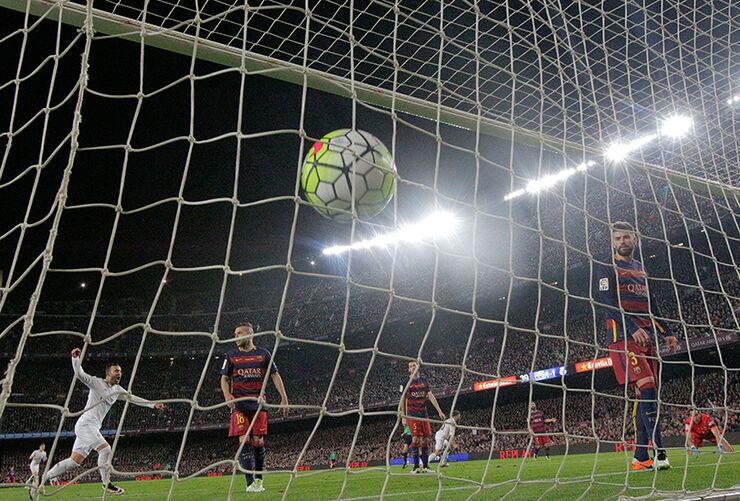


|
| Re: The Top 10 World's Biggest Derbies! (Photos) by timbros(m): 2:09pm On Apr 30, 2016 |
No.1: Boca Juniors vs River PlateNumero uno and the biggest, baddest of them all: Argentina's madhouse big two rivalry...
Football lends itself well to class warfare. Codified at public schools but beloved of the working class, it was exported around the world by a combination of the adventurous officer class and the workers who built empires, military or commercial. And it’s at the heart of the world’s best derby.
Boca-River is not the only rivalry on our list to be sparked by status anxiety and snobbery – leaf through the other 49 and you’ll find plenty of examples of hoi polloi vs bourgeoisie. But it’s the brightest, brashest and most brilliant example of its kind.
Both came from the docks. Club Atletico River Plate were formed in the working-class Buenos Aires dockland neighbourhood of La Boca – oh, yes – in 1901; Club Atletico Boca Juniors popped up nearby four years later, formed by Italian immigrants but taking the idea of their blue-and-yellow livery from a Swedish ship which just happened to float by. The first derby took place in 1908.
Then River moved up in the world, relocating to the affluent northern suburb of Nunez in the mid-’20s. And with the advent of professionalism in 1931, they started throwing money around, buying winger Carlos Peucelle for $10,000 then forward Bernabe Ferreyra for a jaw-dropping $35,000.
Sticks and stones...
That early expenditure earned them the nickname Los Millonarios. It’s stuck ever since, and the class divide has come to define the rivalry. The general perception is that Boca are rugged, River having a reputation for flair.
And of course both sets of fans have embraced the idea with all the enthusiasm of primary school children. Boca call River gallinas (chickens) because they’re gutless, having choked by blowing a two-goal lead against Penarol in the 1966 Copa Libertadores final. River call Boca smelly – chanchitos (little pigs) and bosteros (let’s say “manure collectors”).
The fans have embraced the insults, and so have the players. Boca legend Juan Roman Riquelme – who once said, “When I wake up, I can’t put on anything red or white” – because they’re River’s colours – has happily posed for photos holding signs saying Bosteros.
Carlos Tevez, who returned to his first club Boca in 2015, once celebrated a derby goal by doing the chicken dance. He got a red card for inciting a riot – but then, so did River player Matias Almeyda in 2011 after kissing his badge in front of Boca fans.
The fans have also enjoyed pranking each other. At the turn of the century, Boca fans plastered Buenos Aires in posters listing the musical acts who’d played at River’s El Monumental stadium, noting that while their rivals were watching music Boca were winning trophies. Not ones to miss a trick, River nicked an idea from Pink Floyd and floated a large inflatable pig – wearing a Boca jersey, of course.
El Monumental is a fabled old stadium, venue for nine games at the 1978 World Cup (including the final) and the spiritual home of the massively over-the-top ticker-tape entrance. Boca’s La Bombonera is bonkers-brilliant, a distinctive D-shaped blue-and-yellow affair which literally bounces under the joyous jumping of fans from toddlers to grandmothers.
And what sights those stadiums have enjoyed. Pretty much any world-class Argentine player you can name has played for one side or the other, with plenty of the rest of South America’s talent passing through the portals too.
Pre-eminence and permanence
By the time River splashed the cash that gave them their nickname, Boca had already piled up half-a-dozen league titles, and between them the sides have dominated the trophies ever since. River have won the league 36 times, Boca 31; that’s well clear of nearest challengers Racing on 17.
If that threatens to bolster River’s superiority complex, Boca have a trump card: they’ve won the Copa Libertadores six times to their rivals’ three. It’s all very Liverpool vs Manchester United, except Boca have won four of their continental trophies this century, three of them under Larry-David-lookalike Carlos Bianchi. And just in case they were enjoying that advantage too much, River won the 2015 Copa Lib to cut the lead and keep them on their toes.
Boca also edge the head-to-head record, but River’s relegation in 2011 (they bounced straight back) and a generally more open title race have done little to decrease the determination. It has been described as making the Old Firm game “look like a primary school kickabout”.
Or as Martin Mazur of El Grafico magazine puts it: “A hundred years ago it was about working class vs aristocracy. Today it’s just about hate. The on-pitch atmosphere reflects the 2,000 policemen that patrol the stadium: bust-ups, red cards (two per game is common) and controversy are part of the derby. Attending a Boca-River game, especially at La Bombonera, is a once-in-a-lifetime experience. In the stands you can expect anything – from chicken feathers to flying pigs.” Long may this class war play out for the world's entertainment. 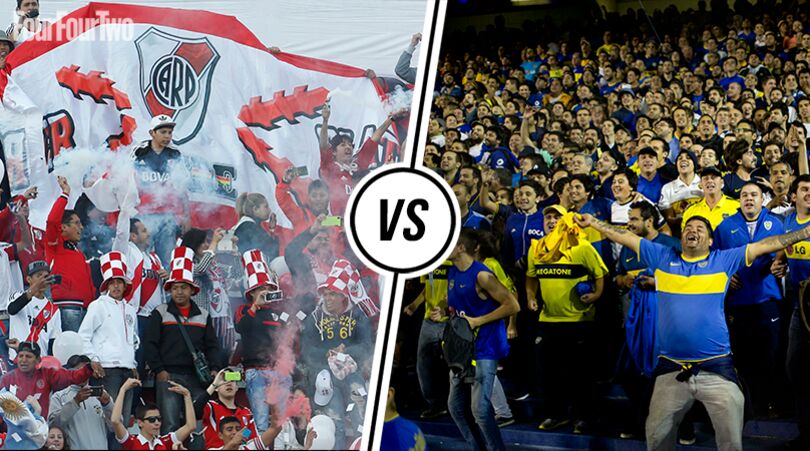

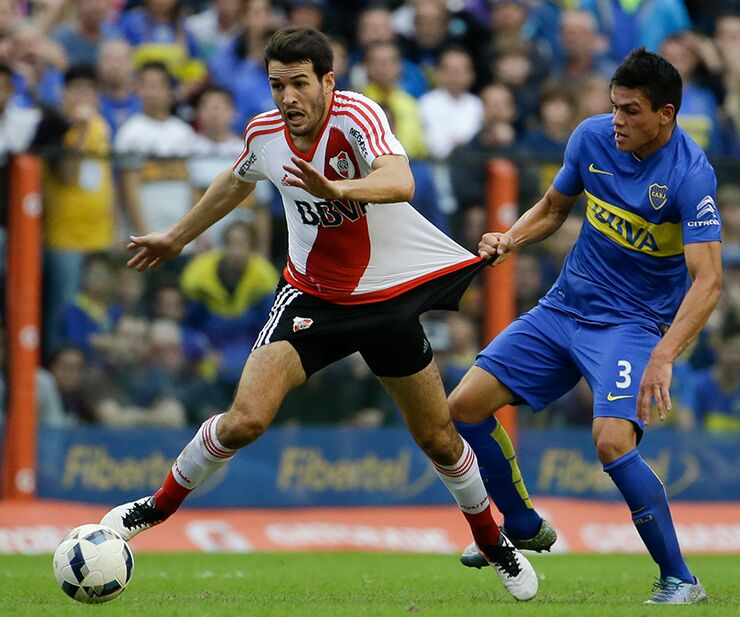

|
| Re: The Top 10 World's Biggest Derbies! (Photos) by timbros(m): 3:35pm On Apr 30, 2016 |
So there you have it: The Top 10 biggest derbies in the world....
What do you guys think? |
| Re: The Top 10 World's Biggest Derbies! (Photos) by Nobody: 3:08pm On May 01, 2016 |
Nice one op. |
| Re: The Top 10 World's Biggest Derbies! (Photos) by timbros(m): 4:13pm On May 01, 2016 |
Thanks |
| Re: The Top 10 World's Biggest Derbies! (Photos) by pamcode(m): 4:53pm On May 01, 2016 |
Whoops took me some mins to finish. Nice write up tho.
CC Lalasticalala |
| Re: The Top 10 World's Biggest Derbies! (Photos) by Malayy(m): 8:49pm On May 03, 2016 |
this op is a goat.. he doesn't know what derby is.. liverpool vs man utd, barcelona vs real madrid.. are not derbies. |
| Re: The Top 10 World's Biggest Derbies! (Photos) by timbros(m): 7:26pm On May 26, 2016 |
Malayy:
this op is a goat.. he doesn't know what derby is.. liverpool vs man utd, barcelona vs real madrid.. are not derbies. Are you okay? Did you even read the first post before embarrassing yourself in the public? How can you be this insulting for no just cause? How old are you please? |